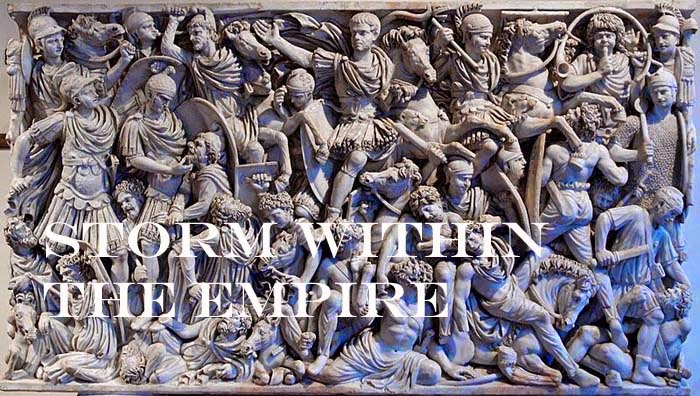The
year 398 AD saw the end of civil strife within the empire, however, the barbarians
were quick to seize an opportunity to invade and plunder the Illyrian region
and the provinces of Asia Minor. This campaign focuses on the eastern conflict
and how it was saved from a Hunnic invasion by the Master of Offices, Eutropius.
The situation in the east was grim as the eastern field army had yet to
return from the West and attempts by the eastern generals to expel the Huns proved ineffective such that
Eutropius took supreme command.
Historically,
the campaign started in the spring of 398 ending with the Huns retreating
across the Caucasus, but for our scenario Eutropius begins preparations in
January of 398 AD.
Later Imperial Rome vs. the Huns
II/78b Eastern Roman Army {1}
1 x general (Cv), 2 x equites (Cv),
2 x horse archer (LH), 3 x legionnaires (4Bd), 3 x auxilia (4Ax), 1 x archers
(4Bw).
II/80d the
Huns
1 x general (Cv or LH), 11 x horse archers (LH).
{1} The Eastern Roman list is modified to reflect the
absence of the field armies and reliance on border troops, therefore the 4Kn
are replaced by Cv and border troops from Mesopotamia, Osrhoenae, and Armenia
replace the palatine units.
398 AD, January to February.
Both sides had spent the winter months in preparation (building
points) for the spring campaign. Eutropius decided to catch the Huns, weakened
by lack of fodder, with a surprise attack in late February.
A few sparse wood and barren fields proved no obstacle
as the Roman army marched forward to meet the Hun. Anticipating their mobility,
Eutropius reinforced his battle line with cavalry and held a small reserve
covering the left.
Moving steadily forward, the legions with auxilia
support swept up the hill to engage the main body under command of their
general. Despite the small loss the Roman infantry were driving the Hun back.
As expected, the Huns probed the left flank but their
effectiveness was blunted by the auxilia and skirmishers. These in fact turned
quickly turned the tide by eliminating large number of horse archers signalling
a retreat of the Hunnic horde. Victory
for Rome, 6 – 2.
398 AD, March.
Quickly following up his victory, Eutropius caught the
Huns in the hilly region of Eastern Anatolia. Both sides were reduced in strength
as the pursuit had outstripped any possibility of reinforcements.
The difficult hills forced the Huns to deploy in two groups,
but this would prove no hindrance as each had clear orders. Rome used the hill
and wood to secure her left flank while the right flank was prepared to execute
their specific orders to counter the Hun threat.
As expected, the Hunnic flank manoeuvre came as no
surprise and Rome countered with a reinforced line. The main Roman body would
use the advantage of number to crush the Hunnic main group.
The reinforced right flank mauled the Hunnic flank
attack while the main Roman group added their efforts to end the battle. Victory for Rome, 3 – 1.
398 AD, April – June.
Pressed by his commanders to continue the pursuit,
Eutropius wanted to replace his losses, though slight by comparison to the Huns
and await news from Constantinople. He reminded his commanders the passes were
still blocked until the summer. By
mid-June the army was ready to deal with the Huns.
After two crushing defeats, the Huns could find little
reinforcement from small groups returning from their forays in Armenia and the
domains of the Sassanid.
The Hunnic main force formed a line between the rocky
hills and wood and as the battle developed began withdrawing allowing the Roman
infantry to advance forward. The only noticeable action was taking place on
their extreme left pulling the Roman cavalry away from the main battle group.
The slow and steady retreat unnerved Eutropius and
confident of the Roman cavalry action on the right moved his cavalry reserve
forward.
As expected, the Huns made an all out effort charging
the Roman line simultaneously in the hope of a breakthrough. It was a valorous
attempt by the Hun, but victory was securely in Roman hands. Score for Rome 3 – 1.
Epilogue
The Huns did carry the booty and slaves off beyond the
Caspian Gate but there would be very few Huns to enjoy their spoils. I am pleased with the results of this
scenario as it duplicated actual events, though it is unknown how many battles were
fought Eutropius was victorious, though short lived.












No comments:
Post a Comment